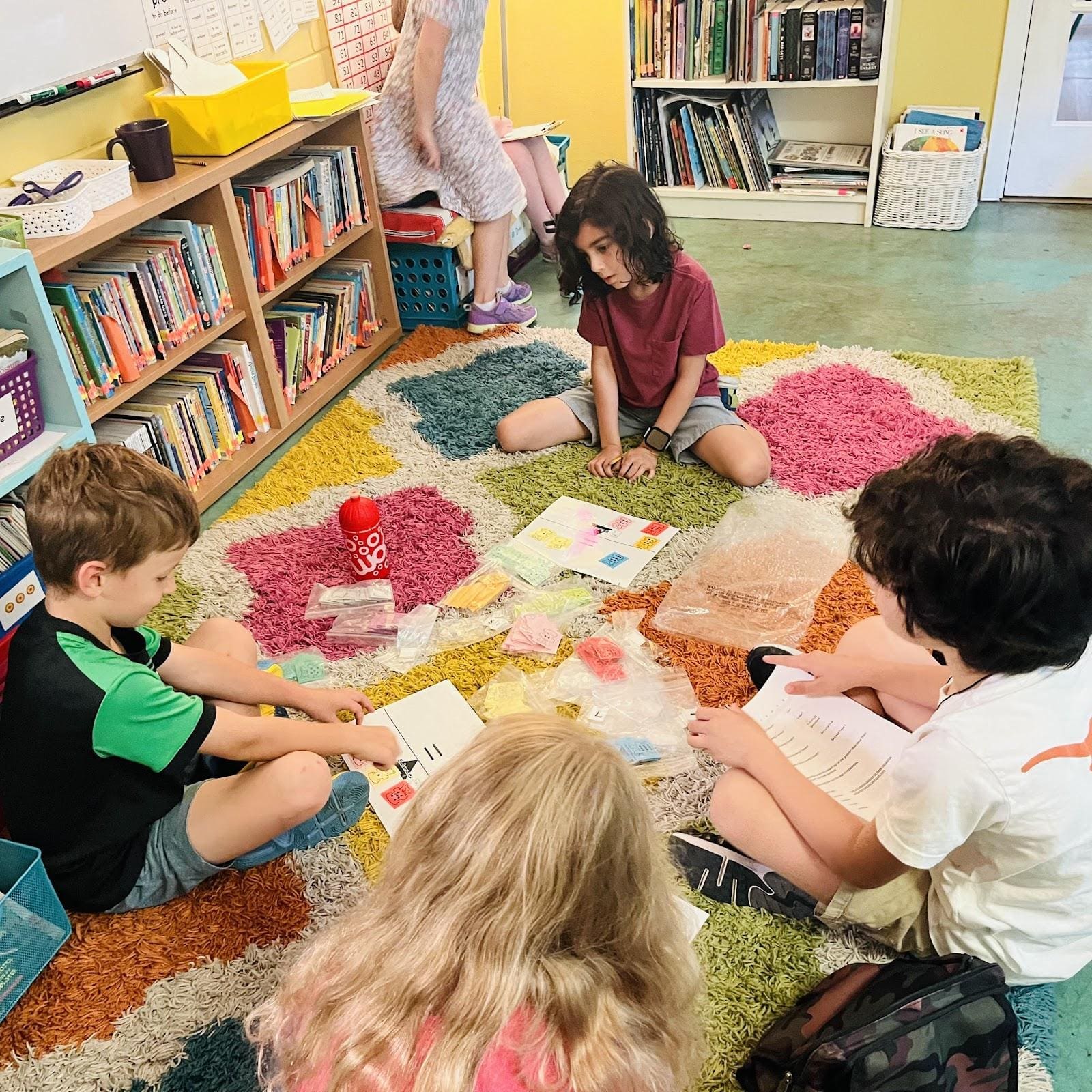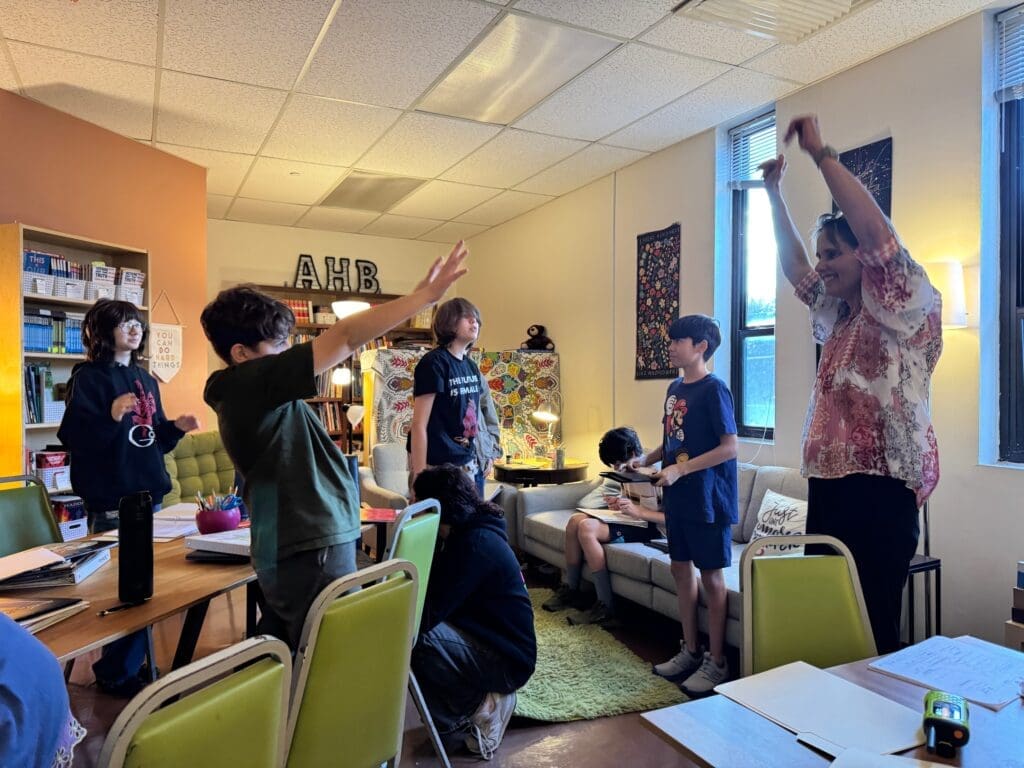Math –
Ms. Andrea’s math group finished off their graphing unit and shone so bright on their posttest!!
We were sure to devote some time to games and student-led equation challenges (aka balancing bears). Next week we’ll finish our end of year assessment and launch into space with a fun, math-centric project!
| 
|
|---|
Ms. Kelly’s crew has been diving deep into fraction comparisons this week! We explored how to compare both fractions with the same denominator and fractions with the same numerator but different denominators. When fractions share the same denominator, it’s all about the numerator—the greater the numerator, the larger the fraction. But when the numerators are the same, we learned that the smaller the denominator, the bigger the fraction. Why? Because fewer pieces mean each part is larger!
To put this into practice, we played a fun game called Dueling Fractions—a fraction-filled twist on the classic card game War. Each player drew fraction bars, wrote out the comparison using <, >, or =, and the player with the greater fraction won the round. 🤺 It was a great way to solidify our understanding while having fun! We wrapped up the week by completing our end-of-unit assessment and celebrating all the growth we’ve made in our fraction journey.

| 
|
|---|
Reading –
Ms. Kelly’s spelling group continues to deepen their understanding of prefixes, with a focus this week on mis-, dis-, and pre-. Alongside our regular word work—reading targeted texts, sorting words, practicing dictation, and breaking big words into syllables—we’ve been honing in on the meanings of each prefix and how they change the meaning of a base word. It’s all about building strong morphological awareness—and let’s just say, morphology rocks!
Ms. Andrea’s spelling group learned spelling patterns that produce long long u sounds, u and /oo/: oo, ui, ew, ou, ue, in addition to words with open syllables (“unicorn”) and a silent e (“flute”).
Book clubs this week: Our Tale of Despereaux group is working together like a well-oiled machine—focused, thoughtful, and full of great discussion! The Eerie Elementary crew is diving into a deliciously spooky part of their story—perfect for giving us goosebumps! 👻 The Bunnicula book club hit a wall of BIG words this week, but tackled them with curiosity and laughter. We had a blast using context clues to crack their meanings and even more fun attempting to pronounce them! 😬 Meanwhile, The Littles book club is already cruising through Chapter 6—so proud of their reading stamina and teamwork!

| 
| 
|
|---|
Writing –
This week, our Beta writers are taking their nonfiction space books to the next level—both in content and creativity! Their ideas for presenting information are imaginative, engaging, and sure to keep readers hooked while learning tons of fascinating facts about space. These books are truly coming to life—and in some cases, taking shape in unexpected, eye-catching ways. It’s inspiring to see just how inventive these kids can be when given the freedom to make their work shine!

| 
| 
|
|---|
Theme –
We’ve gone through our fair share of rocket fuel this week as we’ve been quite busy visiting the four inner rocky planets of our solar system! Our Beta planetary scientists began their epic tour visiting the star at the center of our universe – our sun! We wouldn’t be here without it! We discovered the many layers, and that if it didn’t have its strong gravitational pull, earth would be floating aimlessly out in space!
Next stop, Mercury! This small, dense planet has virtually no atmosphere and rotates very slowly in relationship to the sun. Did you know that a single day on Mercury is equal to 59 days on Earth?? Due to its close proximity to the sun this planet experiences extremely strong solar winds so we did two experiments – first our scientists dropped chocolate chips into flour from various heights and angles to mimic Mercury’s surface and then we used boba straws to blast the flour with “solar winds”…it’s messy work, but someones gotta do it!
We continued onto Venus! Even though Venus isn’t the closest planet to the Sun, it is still the hottest. It has a thick atmosphere full of the greenhouse gas carbon dioxide and clouds made of sulfuric acid. The gas traps heat and keeps Venus toasty warm. In fact, it’s so hot on Venus, metals like lead would be puddles of melted liquid. We created our own carbon dioxide using the tried and true vinegar and baking soda. We discovered c02 is more dense than oxygen and could “pour” it onto a lit match to distinguish the flame. We could also trap the smoke in the co2 to show why Venus is always cloudy.
We zoomed back to Earth, the third planet in our solar system! Earth has only one natural satellite, the moon. The Moon was created around 4.6 billion years ago. It is widely accepted that it formed when Earth suffered a collision with a planet-sized object named Theia. The Moon orbits, or travels around, Earth. It takes the Moon about 27 days to make one trip around Earth. The Moon also spins about its center. It completes one rotation in about 27 days—the same time it takes to complete one orbit. We made our own little models to show how our moon and earth rotate and orbit around the sun.
Last stop this week was Mars! We learned that Mars is a cold desert world. It is half the size of Earth. Mars is sometimes called the Red Planet. It’s red because of rusty iron in the ground. Like Earth, Mars has seasons, polar ice caps, volcanoes, canyons, and weather. It has a very thin atmosphere made of carbon dioxide, nitrogen, and argon. FASCINATING! Next week we explore the gas giants!

| 
| 
|
|---|---|---|

| 
| 
|

|
| 
|
*** Want to see more pictures, videos and more details about each day? Don’t forget to check us out on Instagram! ***
@ Beta_class





